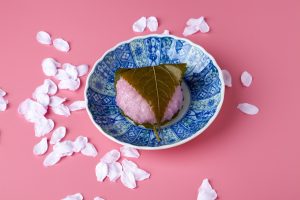 As mentioned in a previous post, we will be exploring tea in Japan. These are the sweets that seem most to fit afternoon tea. So without further ado, we are going to dive right into Japanese Tea Treats
As mentioned in a previous post, we will be exploring tea in Japan. These are the sweets that seem most to fit afternoon tea. So without further ado, we are going to dive right into Japanese Tea Treats
- Monaka-this sweet consists of a wafer shell that can be filled with a sweet bean paste or other sweet meats. The shells of the wafer can be made in many different shapes from simple to more ornate. A popular modern version of this sweet is to fill the shell with ice cream. Since the shell tends to go stale when exposed to air, this sweet much be eaten when fresh as soon as possible.
- Dango- is a sweet dumpling that is made from mochiko which is rice flour related to mochi. This sweet is often swerved with green tea. Although Dango is eaten year around it has different varieties of flavor that are current for the given season. Usually three to four dango are served on a skewer and are best when eaten fresh.
- Daifuku is a pastry with pockets of mochi. It is made of soft rice cake, wrapped around a small round of smooth bean paste or other fillings. The other fillings can be ice cream, vanilla paste, and fruit. After these sweets are made they are covered with a light dusting of potato starch to prevent the sweets from sticking to each other and anything else. Popular variations of Dailfuku include strawberry (ichigo) beans (mame ) and ice cream. They are as popular as cake in the states. However, daifuku needs to be eaten quickly as it will harden.
- Dorayaki is a type of Japanese confection of red bean pancake which consists of two small pancake-like patties made from castella wrapped around a filling of sweet Azuki red bean paste. Other ingredients such as chestnuts, whipped cream are sometime also added to the middle of the pancake.
- Namagashi are traditional Japanese sweets that are most often associated with wagashi. They are made of rice flour and a sweet bean paste filling. Then they are delicately shaped by hand to reflect the season. These sweets are usually served at the traditional Japanese tea ceremony.
I hope you enjoyed this brief description of Japanese sweets. I know I have enjoyed learning and appreciating the different cultural perceptions of tea and how to have tea. In the next post, I will give some recipes of how to make some of these. So stay tuned!
Have a great day,
Alyssa

Recent Comments